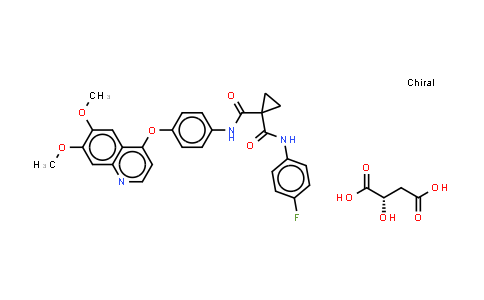Introduction of 1140909-48-3 :
Cabozantinib S-malate (XL184 S-malate) is a potent multiple receptor tyrosine kinases inhibitor that inhibits VEGFR2, c-Met, Kit, Axl and Flt3 with IC50s of 0.035, 1.3, 4.6, 7 and 11.3 nM, respectively. IC50 & Target: IC50: 0.035 nM (VEGFR-2 (KDR)), 1.3 nM (c-Met), 4 nM (Ret), 4.6 nM (Kit), 12 nM (Flt-1), 11.3 nM (Flt-2), 6 nM (Flt-3), 14.3 nM (Tie2), 7 nM (AXL) In Vitro: Cabozantinib (0.1-0.5μM) inhibits the constitutive and inducible MET phosphorylation and its resultant downstream signaling in all MPNST cells. Cabozantinib (> 0.1μM) elicits a significant MPNST cell growth inhibition; higher Cabozantinib doses are needed to inhibit NSC growth. Cabozantinib treatment blocks HGF-induced MPNST motility and invasion (a similar effect of found on NSC)[2]. In cellular assays, cabozantinib inhibits phosphorylation of MET and VEGFR2, as well as KIT, FLT3, and AXL with IC50 values of 7.8, 1.9, 5.0, 7.5, and 42 μM, respectively. Cabozantinib also inhibits tubule formation in response to conditioned media derived from cultures of MDA-MB-231 (IC50=5.1 nM), A431 (IC50=4.1 nM), HT1080 (IC50=7.7 nM), and B16F10 (IC50=4.7 nM) cells[3]. In Vivo: Cabozantinib (60 mg/kg, i.p.) decreases the tumor vascularity with reductions ranging from 67% at 3 mg/kg to 83% at 30 mg/kg for 7 days in animals. Tumors in RIP-Tag2 mice treated for 7 days beginning at age 10 weeks are 40% smaller after XL880 and 35% smaller after Cabozantinib, compared to corresponding values for vehicle[1]. Cabozantinib (30 mg/kg) significantly decreases the microvessel density in mice[2]. Cabozantinib (100 mg/kg, p.o.) inhibits in vivo stimulation of MET phosphorylation by HGF in liver hepatocytes and VEGF-stimulated phosphorylation of FLK1 with inhibition of both targets sustained through 8 hours postdose. Cabozantinib (100 mg/kg, p.o.) disrupts tumor vasculature and promotes tumor and endothelial cell death. Cabozantinib (1-60 mg/kg, p.o.) inhibits tumor growth and promotes tumor regression in vivo[3].
